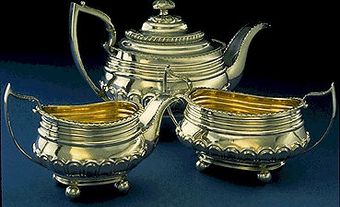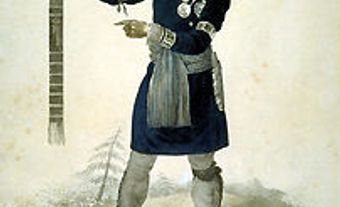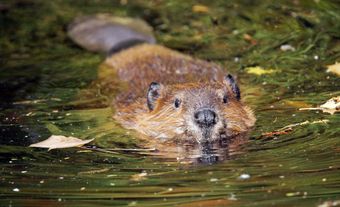Gifts of silver were presented and traded to Indigenous peoples in Canada by European fur traders. Trade
silver was made by silversmiths in Quebec City, Montreal, London and various American cities, including New York, Philadelphia and Detroit. (See also Fur Trade in Canada and Trade Goods of the Fur Trade.)

The Hudson's Bay Company introduced silver in 1790 in regions where competition with the rival North West Company required it. This pendant carries the company mark and the outline of a beaver.
Context
Silver jewellery was traded to the Indigenous peoples by European fur traders from the mid-17th to early 19th centuries. From the earliest exchanges (between seasonal fishermen and the Indigenous peoples) silver played an important role. The first pieces of silver were medals and military gorgets (i.e., crescent-shaped pendants symbolizing rank), presented by the French, British, Dutch and Spanish to their respective Indigenous allies. Then came a number of other designs, based on European fashions and traditions, such as crosses and Luckenbooth hearts, a love token popular in Scotland in the 18th century. Circular brooches of varying sizes, sometimes decorated with engravings or cut-out geometric designs, were very common. Eventually, Indigenous designs were fashioned in silver as well, to produce such items as concave, round brooches that copied similar adornments made from shell in pre-contact times. Earrings, bracelets, headbands, square brooches and animal effigies were also worked in silver for the fur trade.
Making Trade Silver
Trade silver was made by silversmiths in Quebec City, Montreal, London and various American cities, including New York, Philadelphia and Detroit. Because of the high demand between 1780 and 1820, it became a mainstay of the silversmiths' trade. Major Canadian makers included Robert Cruickshank, Charles Arnoldi, Pierre Huguet dit Latour, Joseph Schindler and Narcisse Roy. At times, such masters would employ up to 30 other silversmiths to help meet the demands of fur traders. Larger pieces bore the mark of the silversmith; smaller pieces usually did not. Fashioned from coin silver, usually melted down and shaped or hammered into thin sheets, trade silver was produced in large quantities. (See also Coinage.) The most important requirement from the trader's point of view was that the pieces be thin, both to reduce cost and to make the silver light for transportation into the interior.
Trade Silver, Alliances and the Fur Trade
Silver became a symbol of friendship and alliance and was first used in military alliances during the colonial wars. Later, fur traders presented gifts of silver to the chiefs of Indigenous nations with whom they wanted to trade. Viewed not as a bribe but as a token of goodwill, the practice followed an Indigenous tradition most commonly associated with wampum exchange, and symbolized an agreement between equals.
Eventually, fur traders realized that silver could be a lucrative trade item: small, easy to transport, locally made and much sought after by the Indigenous peoples. An Indigenous hunter might as easily trade three beaver pelts for a silver brooch as for a blanket or iron knife blade. In the fierce competition between the Hudson's Bay Company (HBC) and the North West Company, the British-based HBC tried to avoid introducing silver into its trade because it was a fairly expensive item. However, the Nor'Westers were so successful that the British were forced to introduce trade silver in 1796. In 1821, when they took over control of the Montreal-based NWC, the first item dropped from the trading lists was silver.
Revival
In the mid-19th century, Indigenous silversmiths began to rework some of the larger pieces into smaller items. Eventually, they also fashioned pieces from new silver. Although there was a hiatus during the early part of the 20th century, the period since 1960 has brought a revival of interest in traditional designs. Today, Indigenous silversmiths in eastern Canada are once again producing trade-silver designs for Indigenous and non-Indigenous customers.

 Share on Facebook
Share on Facebook Share on X
Share on X Share by Email
Share by Email Share on Google Classroom
Share on Google Classroom




